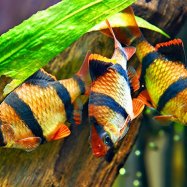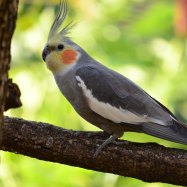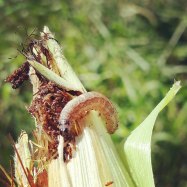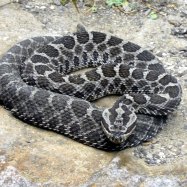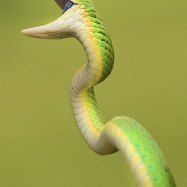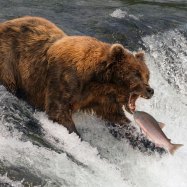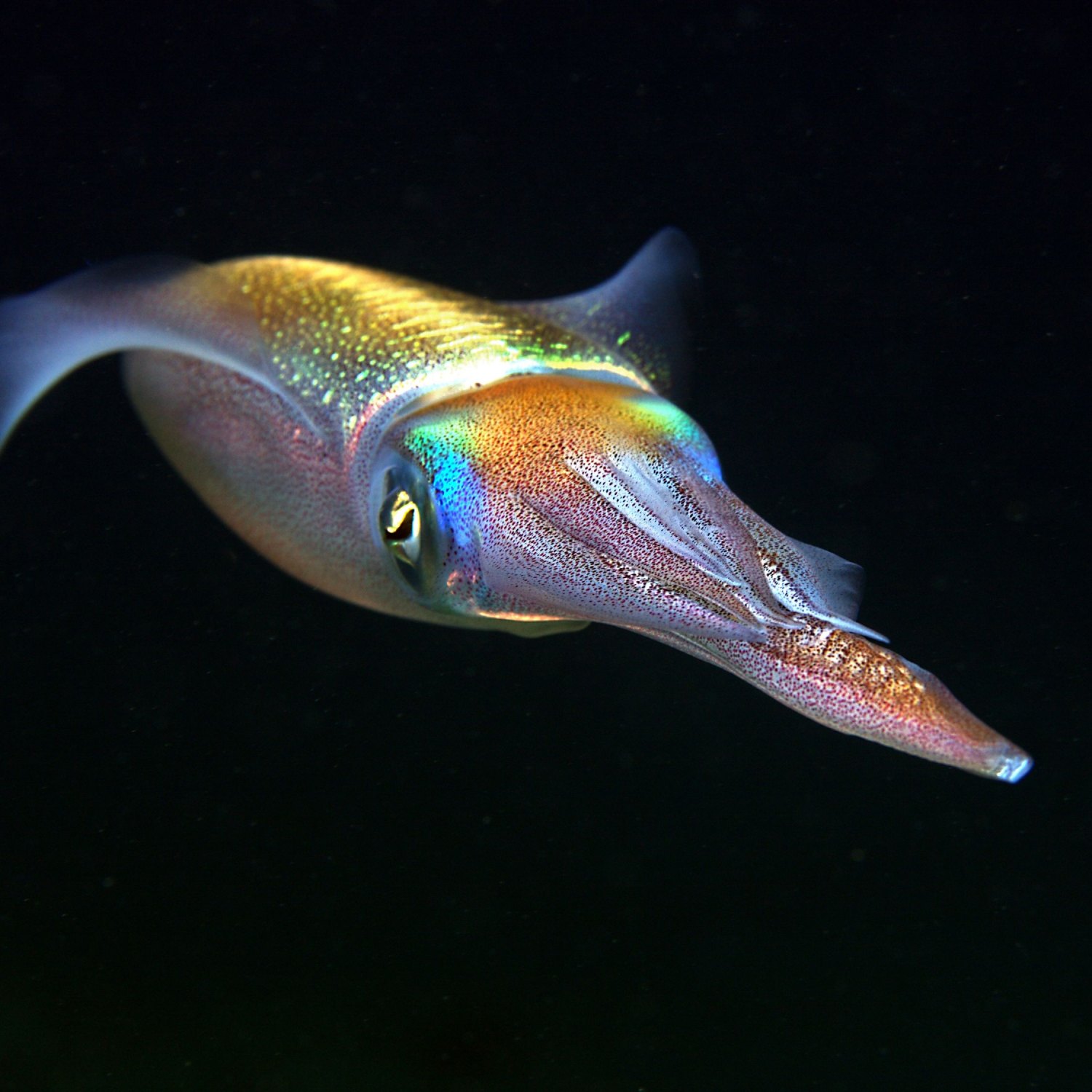
Squid
Up to 60 cm (24 in)
Squid, also known as the 'chameleons of the sea', are fascinating creatures that can quickly change their body color to blend in with their surroundings. With a maximum length of 60cm, they use their tentacles and fins to move through the ocean. Found in oceans worldwide, these members of the Loliginidae family have a unique cylindrical body shape. Explore the depths and discover the wonders of the squid!
Animal Details Summary:
Common Name: Squid
Kingdom: Animalia
Habitat: Marine
The Mysterious and Fascinating World of the Squid
The ocean is a vast and mysterious world, home to a plethora of extraordinary creatures. Among them, resides the intriguing and enigmatic squid. With their unique appearance and elusive nature, these fascinating creatures have always captured the curiosity of humans.Scientifically known as Loligo vulgaris, squids belong to the Kingdom Animalia and the Phylum Mollusca Squid. They are part of the Class Cephalopoda, which includes octopuses and cuttlefish. This diverse group of animals is characterized by their distinctive tentacles and highly advanced nervous system.
Squids are commonly found in the Order Teuthida and the Family Loliginidae. They are widely distributed in the world's oceans, from the shallow coastal waters to the deep abyssal regions. Their preferred habitat consists of temperate and tropical marine environments, making them a vital part of the ocean's ecosystem.
The Appearance of Squids
One of the most striking features of squids is their unique body shape. They have a long and cylindrical body surrounded by eight flexible tentacles and two longer feeding tentacles. These tentacles are lined with powerful suction cups, which they use to capture their prey.In addition to their tentacles, squids also have prominent fins on their body, aiding them in movement and balance Sea Eagle. Their body is covered with a soft, transparent skin, protecting them from predators and allowing them to blend in with their surroundings.
The Hunt for Prey
Squids are fascinating creatures when it comes to their feeding methods. They are carnivorous and highly skilled hunters. With their sharp beak and strong tentacles, they can catch and consume a variety of prey, including fish, crustaceans, and even other squids.They use their tentacles to swiftly capture their prey and bring them towards their mouth, where their beak breaks down the food into smaller pieces. This efficient feeding process allows squids to quickly consume their prey and sustain their energy levels.
Global Distribution and Origin
Squids are widely distributed in various parts of the world, making them a cosmopolitan species. They are found in all the world's oceans, from the Arctic to the Antarctic. Due to their adaptability, they can thrive in different marine environments, such as coral reefs, seagrass beds, and even the open ocean.Although squids are found all over the world, it is challenging to pinpoint their exact country of origin. These elusive creatures tend to cover vast distances, making it difficult to determine where they originated from.
The Stunning Coloration of Squids
One of the most intriguing features of squids is their coloration. They have the uncanny ability to change colors, patterns, and even textures, helping them in camouflage and communication with other squids.Depending on the species, squids can range from transparent to vibrant hues of pink, red, and purple. These colors are a product of pigment cells in their skin, called chromatophores, which expand and contract to produce different shades and patterns.
The Physical Dimensions of Squids
Squids come in a range of sizes, depending on the species. On average, they can grow up to 60cm (24 inches) in length, with some reaching lengths of up to 13 meters (43 feet). The Giant Squid, found in the deep ocean, is the largest known invertebrate in the world, with eyes the size of dinner plates and a body that can measure over 10 meters (33 feet).Despite their impressive size, squids are lightweight animals due to their soft and flexible bodies. This allows them to swim effortlessly through the water and makes them agile and quick in hunting their prey.
A Notable Unique Feature – The Ink Defense
An exceptional defense mechanism of squids is their ability to release a cloud of dark ink when threatened. This ink consists of melanin and mucus, giving it a dark color and a slimy texture. The sudden release of ink can confuse the predator and give the squid enough time to escape to safety.This defense mechanism has been adapted throughout evolution, as squids have been preyed upon by larger animals, such as sharks and whales. It is an excellent example of their adaptation to their surroundings and their survival instincts.
The Role of Squids in the Ecosystem
Like all creatures, squids play an essential role in the ocean's delicate ecosystem. As predators, they help to regulate the population of their prey species, making sure that the food chain remains balanced. They are also a vital food source for many marine animals, including fish, birds, and other squids.Additionally, squids play a crucial role in nutrient cycling in the ocean. When they die, their bodies sink to the ocean floor, providing nutrients to the creatures living in the deep sea. Moreover, the ink released by squids contains high levels of nitrogen, which contributes to the ocean's nutrient-rich environment.
Squids and Their Connection to Humans
Squids have a long and intriguing history with humans. In ancient times, they were considered to be sea monsters and were depicted in various myths and legends. They have also been a source of food for humans, with many cultures incorporating them into their traditional cuisine.Moreover, the unique features of squids have inspired many inventions. Their sharp beak and flexible tentacles have influenced the design of surgical instruments, while their tentacles have inspired the development of robotics and artificial intelligence.
The Future of Squids
Unfortunately, like many marine animals, squids have also faced the threat of overfishing and habitat destruction. As a result, some species of squids are facing endangerment and potential extinction. It is crucial to understand and protect these fascinating creatures to maintain the balance of the ocean's ecosystem.In recent years, there has been a growing interest in studying squids and their behavior. With advancements in technology, researchers have been able to learn more about these elusive creatures, shedding light on their habits and ecological role.
In Conclusion
In the vast and mysterious world of the ocean, squids hold a special place. With their unique appearance, impressive abilities, and vital role in the ecosystem, they have captured the fascination of humans for centuries. As we continue to explore and learn more about these creatures, may we always be in awe of their beauty and significance in the ocean's ecosystem.

Squid
Animal Details Squid - Scientific Name: Loligo vulgaris
- Category: Animals S
- Scientific Name: Loligo vulgaris
- Common Name: Squid
- Kingdom: Animalia
- Phylum: Mollusca
- Class: Cephalopoda
- Order: Teuthida
- Family: Loliginidae
- Habitat: Marine
- Feeding Method: Carnivorous
- Geographical Distribution: Worldwide
- Country of Origin:
- Location: Oceans
- Animal Coloration: Transparent to pink, red, and purple
- Body Shape: Cylinder-shaped with tentacles and fins
- Length: Up to 60 cm (24 in)
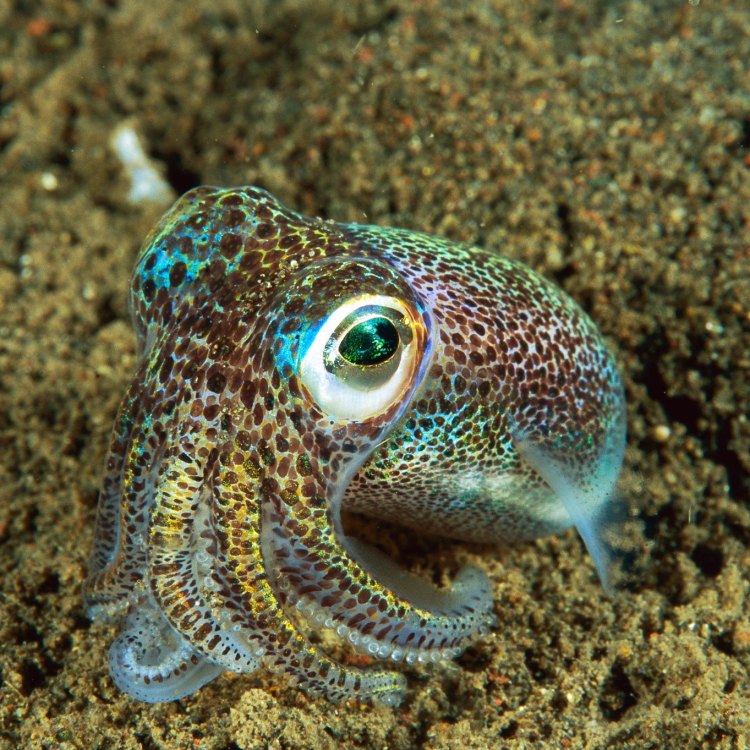
Squid
- Adult Size: Medium-sized
- Average Lifespan: 1-2 years
- Reproduction: Sexual
- Reproductive Behavior: Males use specialized arms to transfer sperm packets into the female's body
- Sound or Call:
- Migration Pattern: Some species migrate vertically in the water column
- Social Groups: Solitary or in small groups
- Behavior: Agile swimmers and camouflage experts
- Threats: Overfishing, pollution, habitat destruction
- Conservation Status: Data Deficient
- Impact on Ecosystem: Important prey species for many marine predators
- Human Use: Culinary use, fishing, research
- Distinctive Features: Large eyes, long tentacles, powerful beak
- Interesting Facts: Squids have the ability to change the color and pattern of their skin to blend in with their surroundings
- Predator: Sharks, dolphins, whales, and larger fish
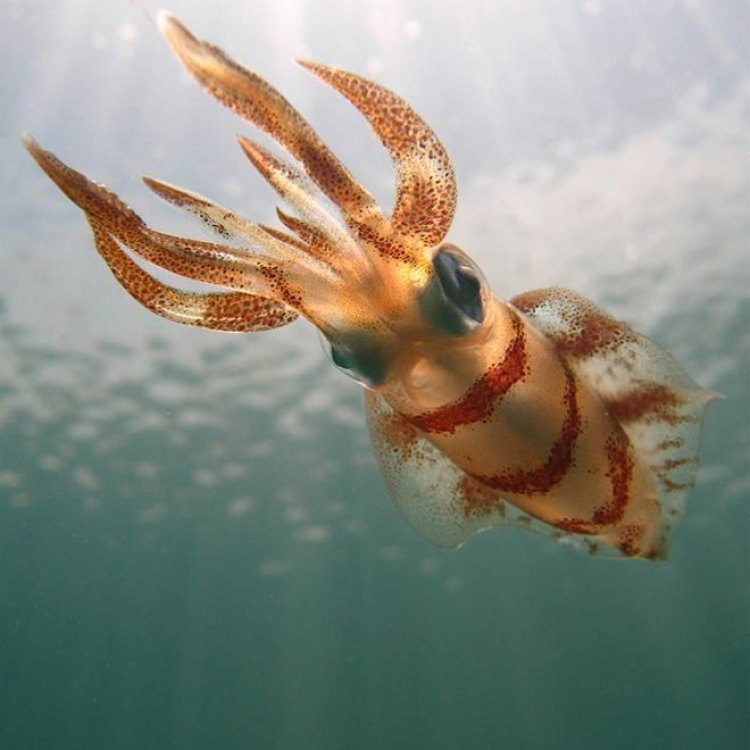
Loligo vulgaris
A Hidden Master of the Ocean: The Fascinating World of Squids
The ocean is home to thousands of creatures, both small and large, that captivate us with their unique features and fascinating behaviors. From the majestic blue whale to the tiny clownfish, there is always something new and interesting to learn about these incredible creatures. One such ocean dweller that often goes unnoticed and underestimated is the squid.With their large eyes, long tentacles, and powerful beaks, squids may seem like just another type of fish PeaceOfAnimals.Com. However, these peculiar creatures are quite different from your typical fish. They belong to the cephalopod family, which also includes octopuses and cuttlefish, and are known for their intelligent and adaptive nature.
In this article, we will dive into the hidden world of squids, exploring their physical characteristics, behavior, and impact on the ecosystem. We will also take a closer look at the threats they face and their conservation status, as well as how humans have interacted with these creatures throughout history.
The Adult Size and Average Lifespan of Squids
Squids are classified as medium-sized creatures, with the average size ranging from 2.5 to 6 feet in length, although some species can reach up to 50 feet! These creatures can weigh anywhere from a few ounces to hundreds of pounds, depending on their species.
Their average lifespan is relatively short, only living for 1-2 years. However, some species, such as the deep-sea squid, have been known to live for up to 5 years. The shorter lifespan is due to their rapid growth and high metabolic rates, making them active and agile creatures Spotted Skunk.
Reproduction and Reproductive Behavior
Like many other creatures, squids reproduce sexually. Mating usually occurs near the surface of the water, where male squids use specialized arms called hectocotylus to transfer sperm packets into the female's body. These arms are also used to remove any competing sperm that may be present.
Squids have a unique reproductive strategy where they lay their eggs in protective clusters called egg cases. These egg cases can hold anywhere from a few hundred to thousands of eggs, depending on the species. The eggs then hatch into tiny squids, known as larvae, which must fend for themselves immediately.
Sound or Call
Squids do not produce any significant sounds or calls. However, they do have a unique way of communicating with each other through their highly developed sense of touch. Their skin is covered in tiny sensory cells that can detect even the slightest pressure changes in the water, allowing them to communicate with each other over long distances.
Migration Patterns and Social Groups
Squids are highly adaptable creatures, and their migration patterns can vary depending on their species and habitat. Some species, such as the North Pacific giant squid, migrate vertically in the water column, traveling between the depths of the ocean during the day and the surface at night.
In terms of social groups, squids are primarily solitary creatures. However, some species do form small groups for hunting or mating purposes. Due to their short lifespan, they do not have complex social structures like some other marine creatures.
Behavior and Distinctive Features
Squids are agile swimmers and are known for their quick bursts of speed, making them efficient predators. They use their large eyes to have excellent vision and hunt for prey, and their long tentacles and powerful beaks help them capture and subdue their prey.
What sets squids apart from other creatures is their remarkable ability to change the color and pattern of their skin to blend in with their surroundings. This adaptation allows them to hide from predators and sneak up on their prey.
Threats to Squids and Its Impact on the Ecosystem
Unfortunately, squids face numerous threats in the ocean, which puts their survival at risk. Overfishing, pollution, and habitat destruction are the primary threats to their population. Squids are a crucial prey species for many marine predators, and their decline could have a significant impact on the food web and ecosystem.
Overfishing is a significant concern, with squids being a target for commercial fishing due to their culinary use and popularity in research. The decline in their population could also indirectly affect humans, as squids are an important food source for many marine animals consumed by humans.
Pollution and habitat destruction also pose a significant threat to squids. Ocean pollution, such as plastic and chemical waste, can harm or kill squids and their prey, and damaged habitats can make it difficult for squids to thrive and reproduce.
Conservation Status: Data Deficient
The conservation status of squids varies depending on their species. The Humboldt squid and the longfin inshore squid, both popular in the fishing industry, are considered "least concern" by the International Union for Conservation of Nature (IUCN).
However, other species, such as the market squid and the European flying squid, are classified as "data deficient," meaning there is not enough information to determine their population trends and conservation status accurately. This lack of data further highlights the need for more research and monitoring to protect these remarkable creatures.
Human Use and Interesting Facts
Humans have a long history of interacting with squids, primarily for culinary use and research. Squids are a staple in many cuisines worldwide and are consumed both cooked and raw. Their high protein content and low fat make them a healthy and popular choice for seafood lovers.
Squids are also vital in research, with their highly developed nervous system and unique physiological features making them ideal for neurobiological and behavioral studies. Their ability to change color and pattern has also inspired scientists to develop advanced camouflage technologies.
Along with these human uses, squids also have many interesting facts that make them stand out among other sea creatures. For example, some deep-sea squids have striking bioluminescent capabilities, able to produce their own light through chemical reactions in their bodies. This adaptation allows them to communicate, attract prey, and even confuse predators.
Predators of Squids
Despite their remarkable abilities, squids have several natural predators, including sharks, dolphins, whales, and larger fish. These predators have evolved to hunt and feed on squids, making them a crucial part of the ocean's food web.
Sharks and dolphins, in particular, have been known to prey on squids for centuries. The famous surfer giant squid, commonly depicted in literature and films, is a testament to the real-life battles these creatures engage in with their natural predators.
Conclusion
In conclusion, squids are truly fascinating creatures that have much more to offer than meets the eye. From their unique physical features and behaviors to their role in the ecosystem, squids are essential for maintaining the delicate balance of the ocean.
As humans continue to explore and exploit the ocean's resources, it is crucial to remember the impact we have on these remarkable creatures and the need for conservation efforts to protect them. With their conservation status currently listed as "data deficient," it is clear that more research and awareness is needed to ensure the survival of these hidden masters of the ocean.
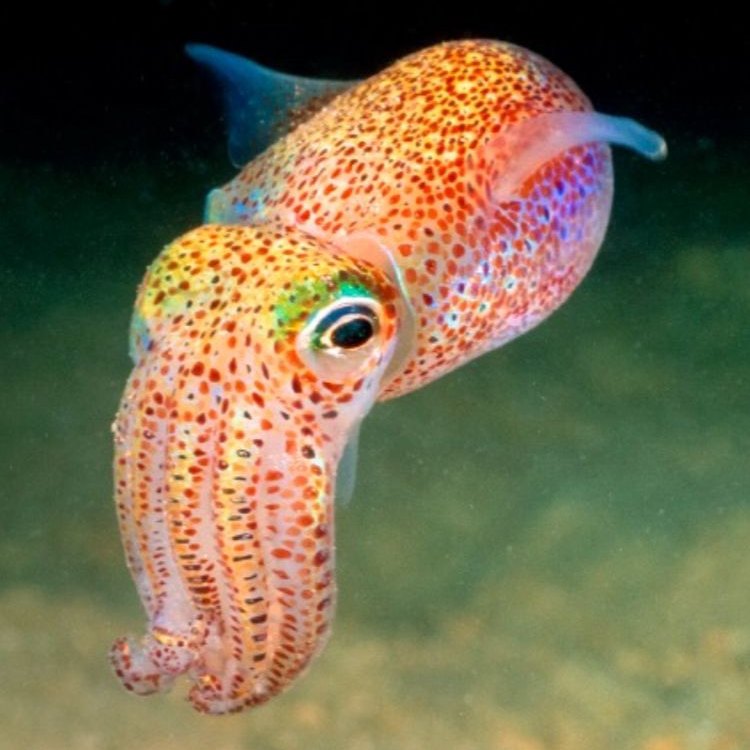
The Mysterious and Fascinating World of the Squid
Disclaimer: The content provided is for informational purposes only. We cannot guarantee the accuracy of the information on this page 100%. All information provided here may change without prior notice.

